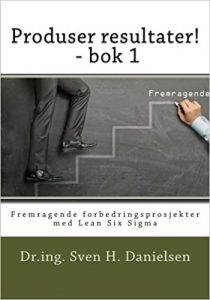Green Belt – Lean Six Sigma
This 8-day course provides a comprehensive introduction to Lean, Six Sigma, selected parts of Business Process Management (BPM), and Agile methods.
Six Sigma is a practical method for executing all types of improvement projects*.
Lean, with relevant additions, includes the best practice methods, tools, and processes that an organization needs to ensure operational control and continuous improvement.
*) including digitalization.

Language
This coming Green Belt Lean Six Sigma course will be conducted in Norwegian or English.
Course Format
The course has a hybrid format:
- Session 1 (Days 1 and 2) is conducted in the classroom with a concurrent online broadcast via Microsoft Teams.
- Session 2 (Days 3 and 4) is conducted in the classroom with a concurrent online broadcast via Microsoft Teams.
- Session 3 (Days 5 and 6) is conducted in the classroom with a concurrent online broadcast via Microsoft Teams.
- Session 4 (Days 7 and 8) is conducted in the classroom with a concurrent online broadcast via Microsoft Teams.
Target Audience
- Managers who want to improve operational performance
- Managers who need to carry out targeted improvement projects*
- Project managers for improvement projects*
- Project participants in improvement projects*
- Individuals working with improvement efforts, quality, environment, and sustainability
*) including digitization
Content
The content has been systematically developed in collaboration with several top executives and improvement experts from 2002 to the present.
-
Sessions 1 and 2 - Improvement Projects Using Practical Six Sigma
These sessions provide a thorough introduction to the methods and tools for the successful execution of improvement projects using practical Six Sigma.
Key topics include:
- Roles and responsibilities in Six Sigma improvement projects
- How to define and scope improvement projects
- How to create a clear problem statement
- How to describe project benefits
- How to ensure optimal communication with project stakeholders
- How to visualize cause-and-effect relationships
- How to use data and process maps in the analysis of cause-and-effect relationships
- How to analyze risk
- How to prioritize and select solutions in the short and long term
- How to ensure lasting/sustained improvements
- How to reuse project results
- Template for project documentation and reporting
-
Sessions 3 and 4 - Lean and Continuous Improvement
These sessions provide a thorough introduction to the common structures an organization needs to ensure operational control and continuous improvement.
Key content includes:
- How to map stakeholders, customers, and requirements for an area of responsibility (e.g., a department)
- How to map the processes involved in the area of responsibility (e.g., a department)
- How to populate the “stop doing” list with the right content
- How to design meeting structures and visual boards for operational control and replanning
- How to use Agile methods such as Kanban and Scrum in activity management
- How to design and implement processes for continuous improvement
- How to reorganize the physical workspace using 5S
- How to establish preventive maintenance of assets
- How to assess competence needs in the short and long term
- How to define standard work for leaders
Practical Information
-
Overview of Tools and Methods
The following tools are covered:
- Brainstorming
- Brainwriting
- Problem Statement
- SIPOC
- Mapping Customer Requirements
- CTQ tree
- Communication Plan
- Progress Plan
- Business Case
- Fishbone Diagram
- 5 Whys
- Value Stream Mapping
- Spaghetti Diagram
- Flowchart
- Functional Flowchart
- Value Flow Diagram
- Process Design
- FMEA (Failure Mode and Effects Analysis)
- Risk Matrix
- Fault Tree Analysis
- Priority Matrix
- PICK Chart
- Histogram
- Control Chart
- Pareto Diagram
- Six Sigma Roadmap
- Six Sigma Storyboard
- Six Sigma Project Charter
- Context Diagram
- A3 Problem Solving
- 8D Problem Solving
- Various Proactive and Reactive Improvement Structures, including Kaizen Event, Kaizen Circle, and Kaizen Workshop
- Scrum and Kanban Activity Management
- Workplace Organization using 5S
- Reducing changeover time with SMED
- OEE (Overall Equipment Effectiveness)
- One-Point Lessons
- Leader’s Standard Work
Some of the methods and tools are described in depth, while others are covered at an introductory level.
-
You will receive this 2 weeks before the course start.
- Agenda for the course
- Recommended preparations
- Access to animated training for the two topics (as preparation and support during the course)*
- Access to a library of improvement tools covered in the course*
- Guidelines for selecting an improvement project
- Requirements for diploma and certification
- Other practical information
-
Focus on skills through practice and repetition
In the courses, methods and tools are practiced through exercises in breakout rooms. The results of the group work are presented and discussed.
To ensure the best possible engagement and learning, time is spent each day on reviewing and discussing the theory covered.
-
Own Project, Diploma, and Certification
To get the most out of the course, we recommend that you complete a Six Sigma improvement project. Several of the course exercises can then be conducted based on your specific issue. You also have the opportunity to receive valuable feedback on your project from the instructor and other course participants.
Diploma and Certification
Diploma: To receive a diploma for successful completion, you must have attended all sessions and at least 6 out of 8 course days.
Certification, Level 1: At the end of the course, participants can take a multiple-choice test. 40 questions must be answered, with a minimum of 75% correct answers required to earn a Lean Six Sigma Green Belt certificate, Level 1. The test is conducted in our training portal, ProErigo Academy, and is included in the course fee. The test is optional.
Certification, Level 2: To be certified as Green Belt Level 2, participation must meet the diploma requirements (above), along with the successful completion of a Six Sigma improvement project within 12 months after the course ends. The project is considered approved if the project owner has approved the project and Aksena has approved the approach, tool usage, and documentation. By agreement, other projects besides Six Sigma projects can also be approved.
-
The following is included in the course
- Electronic version of the course material
- Course compendium for those attending in person
- Lunch provided every day
- Template for documentation of improvement projects (storyboard)
- Template for A3 problem solving
- Template for FMEA
- Template for criteria matrix and priority matrix
- Template for project charter
Accommodation related to the course must be organized and paid for by the participants themselves.
- Relevant Literature
- March 18, 2026 – March 19, 2026
- April 15, 2026 – April 16, 2026
- April 29, 2026 – April 30, 2026
- May 20, 2026 – May 21, 2026



